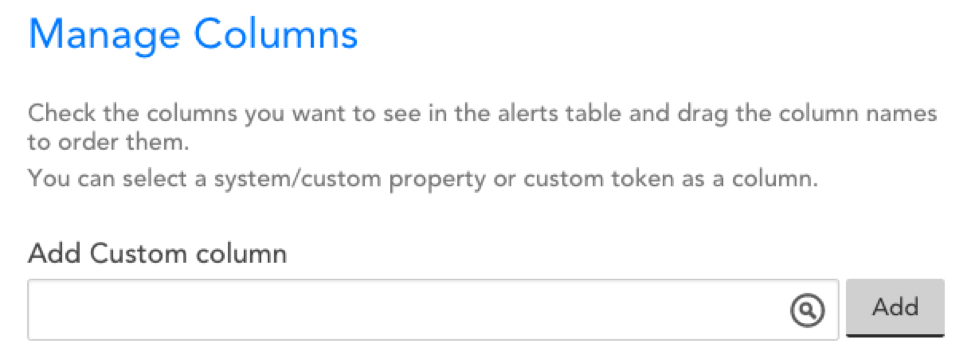We will be rolling out the v.80 Release through the second week of September. This release comes with several big improvements- including v2 of Remote Session and changes to our Alerts Table- as well as some new features, namely a suite of Rest API resources for Device Groups.
Remote Session v.2
We are happy to introduce v.2 of Remote Session. This new version streamlines the process for remotely accessing and operating on devices within your LogicMonitor account. Most importantly, we have implemented a copy-and-paste functionality that allows you to easily introduce pre-written commands on your device.
Alerts Table Improvements
We have included an “Add Custom Column” field to the Alerts Table which lets you add columns that display system properties, autoproperties, and/or LM tokens. This will markedly expand the device or instance-level information immediately available to you when troubleshooting alerts. It can also be particularly useful for adding ticket-related information such as external ticket IDs and URLs.
AWS (EC2) Netscan Improvements
AWS (EC2) Netscan now has an “Inherit Credentials from Group” option that will apply a device group’s preconfigured AWS credentials to your Netscan policy. We previously required you to manually specify credentials for every scan.
ILP change to Auto.

Instance Level Properties will now be prepended with auto. rather than system. This is meant to distinguish ILPs from our typical system properties, which are inherent in LogicMonitor and can not be customized.
REST API Device Group Resources
We published the ability to add, get, update, and delete Device Groups via our REST API. See our detailed documentation for more information.
Other Improvements
Alerts
- When you drag an in-alert device to a group with alerting disabled, its active alerts will be cleared. This is consistent with the behavior of disabling alerting for a specific device.
Dashboards and Widgets
- Improved dashboard performance when loaded in Firefox.
- Shared dashboards can contain a maximum of 100 widgets. This ensures expected performance.
Devices
- The Add Device Wizard duplicate device logic only requires IP addresses/DNS names to be unique to the Collector. Previously, it did not allow duplicate DNS names/IP addresses within an entire account.
- The Collector status icon will now reflect Collector SDTs.
- Two new properties, system.createdon and system.updatedon, have been added for devices.
- We added a new Collector Dead icon to the device tree. This icon lets you differentiate between a dead device and a functional device with a dead Collector.
- Allow users to remain signed-in even if inactive for 30 minutes.
Reports
- Generated reports are now displayed via a shorter and more readable link.
- Expired report links are no longer displayed within the Reports Page.
Services
- Name filters for AWS SQS, Lambda, and ECS Services have been added. Because these do not support AWS tags, name filters allow you to easily indicate which resources LogicMonitor should add into monitoring.
Settings
- The following characters are now acceptable for use in passwords: @ # & \ | ; : , < > . ? /
- API Tokens can now be deleted. Additionally, they can be re-enabled after having been disabled.
- We display global thresholds when viewing the Alert Tuning tab for datasources.
- All integrations now have the option to include custom headers.
- When an AWS device is automatically deleted, this action will be reflected in the audit log.
- Updated the Display Name column for the Netscan unmonitored devices group and added a DNS column.
- Combined the Add Credit Card and ACH Payment Method buttons into one Add Payment button.
- A new comparison operator, ‘NOT IN”, is available for eventID filters set in Eventsources. This feature is only supported in Collector version 22.050 or greater.
Bugs Fixed
Alerts
- Eventsource alerts were not always matching the proper alert rule.
- The instance filter on the Alerts Page was not working well for instances with special characters (e.g. ‘\’) in the name.
- A recent Alert Rule update caused all device groups to be added to Alert Rules by default. This has been corrected. The glob character ‘*’ will only be automatically added if no device groups are specified.
Dashboards and Widgets
- We have improved performance for dashboards set to time ranges equal to or greater than 1 year.
- The Services widget did not properly filter available services based on sub-group.
- When cloning a row in the Table Widget, the instance value was not automatically updated if the device was changed.
Devices
- When using the Device Wizard to add a device, a prompt always displayed for
the SNMP community string regardless of whether the property already existed at the group level. - Device properties with a trailing space could not be edited from the Manage Device screen.
Services
- When Service Default Settings were not changed from their original configuration, new services set to these default settings would not always properly adopt them.
- Internal Service checkpoints (i.e. Collectors) were not displaying correctly in the “Select Checkpoint” dropdown within the Raw Data tab.
Settings
- Netscan policies configured to trigger an email upon completion were not successfully sending those emails.
Minor Bug Fixes
- The !netflow debug command was not working well in certain cases.
- Fixed a few minor issues with cloning reports.




